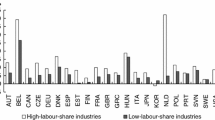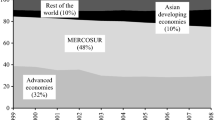Summary
In this paper we argue that previous studies of the impact of imports of Western capital to the Soviet Union have erred by emphasizing the direct contribution of such capital to output. To our view, a more important consequence of such imports is a catalytic effect on the productivity of indigenous capital and labor cooperating with Western machinery. Estimates of production functions for Soviet industry and several subsectors indicate that Western capital imports do improve the productivity of indigenous inputs and make the production process more capital intensive.
Similar content being viewed by others
References
Donald W. Green and Herbert S. Levine, ‘Implications of Technology Transfer for the U.S.S.R.,’ in: N.A.T.O.,East-West Technological Cooperation, (Brussels: N.A.T.O. Economic Directorate, 1976) and Donald W. Green and Herbert S. Levine, ‘Soviet Machinery Imports,’Survey, 23 (1977–78), pp. 112–126.
Martin L. Weitzman, ‘Technology Transfers to the U.S.S.R.: An Economietric Analysis,’Journal of Comparative Economics, 3 (1979), pp. 167–177, and Yasushi Toda, ‘Technology Transfer to the U.S.S.R.: The Marginal-Productivity Differential and the Elasticity of Intra-Capital Substitution in Soviet Industry,’Journal of Comparative Economics, 3 (1979), pp. 181–194.
Phillip Hanson, ‘Technological Transfer to the U.S.S.R.,’Survey, 23 (1977–78), pp. 73–104, estimates that between 1955 and 1975 imports of Western machinery have accounted for from 0.8 to 2.4 or 1.6 to 4.8 percent of annual Soviet capital formation depending on the exchange rate chosen for converting foreign into domestic prices.
Anthony C. Sutton,Western Technology and Soviet Economic Development (3 volumes), Stanford, CA., 1968, 1971, 1973.
Anthony C. Sutton,op. cit., Western Technology and Soviet Economic Development, Vol. 3, Chap. 18.
Phillip Hanson, ‘The Impact of Western Technology: A Case-Study of the Soviet Mineral Fertilizer Industry,’ in: Paul Marer and J. Michael Montias, (eds.),CMEA Integration and East-West Trade, Bloomington, 1981.
Central Interllligence Agency,Prospects for Soviet Oil Production, Washington, 1977.
We are indebted to Professor Robert Campbell for this example.
Stanislaw Gomulka, ‘Growth and the Import of Technology: Poland 1971–1980,’Cambridge Journal of Economics, 2 (1978), pp. 1–16.
The better results for Chemicals may be due to the large amounts of Western equipment utilized in that sector. The lack of parameter estimates that are significantly different from zero plagues the Green-Levine and Weitzman studies as well. Green-Levine are able to obtain parameter estimates significantly different from zero by imposinga priori constraints on some parameters and estimating the rest. Weitzman produces a number of specifications for which none of the parameter estimates appear to be significantly different from zero. The main difficulty is that the growth rate of the capital stocks and of output are so regular that they exhibit a high degree of multicollinearity even when they are first-differenced. Consequently the standard errors are inflated.
The bordered Hessian of the production function is indefinite in sign.
Abram Bergson, ‘Soviet Economic Perspectives: Toward a new Growth Model,’Problems of Communism, 22 (1973), pp. 1–9.
Author information
Authors and Affiliations
Rights and permissions
About this article
Cite this article
Brada, J.C., Hoffman, D.L. Technology transfer to the U.S.S.R and the shape of the production function. De Economist 130, 420–427 (1982). https://doi.org/10.1007/BF02371750
Issue Date:
DOI: https://doi.org/10.1007/BF02371750




